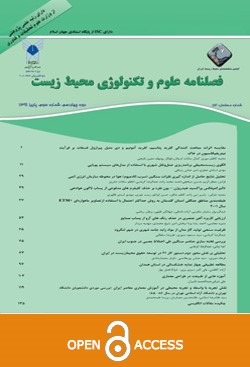بررسی حذف بیولوژیکی سیانور از فاضلاب ساختگی و شناسایی میکروارگانیزمهای مقاوم به سیانور
محورهای موضوعی : آلودگی محیط زیست (آب و فاضلاب)
میرمهرداد میرسنجری
1
,
غلامرضا سیاحتی اردکانی
2
![]()
1 - استادیار، گروه محیط زیست، دانشکده منابع طبیعی و محیط زیست، دانشگاه ملایر، ایران
2 - استادیار، گروه محیط زیست، دانشکده کشاورزی و منابع طبیعی، دانشگاه اردکان، ایران *(مسئول مکاتبات).
کلید واژه: سیانور, فاضلاب, حذف بیولوژیکی, میکروارگانیزمها, تصفیه هوازی,
چکیده مقاله :
زمینه و هدف:یکی از پیامدهای فعالیت های صنعتی، ورود ترکیبات سمی نظیرسیانور به محیط زیست است که بی توجهی به آن سلامت انسان و سایر موجودات زنده را تهدید می کند. مطالعه حاضر به منظور بررسی حذف بیولوژیکی سیانور از فاضلاب و شناسایی میکروارگانیزم های مقاوم انجام شد. روش بررسی: فاضلاب ساختگی از سیانور پتاسیم تهیه شد و در راکتور جریان منقطع (ناپیوسته) با ظرفیت 2 لیتر، غلظت های 5،20، 50، 100، 150 و 200 میلی گرم در لیترسیانور مورد بررسی قرارگرفت. لجن ثانویه تصفیه خانه فاضلاب شهری به عنوان محیط کشت مخلوط در راکتور به کار رفت. میزانCN، NH3، NO3، TSS، VSS و باکتری ها بر اساس روش های موجود در کتاب استاندارد متد اندازه گیری شد. همچنین شناسایی روتیفرها، مژه داران و جلبک ها نیز با استفاده از میکروسکوپ مدلIIS انجام شد. یافتهها: نتایج نشان داد که تصفیه بیولوژیکی می تواند تا غلظت 150 میلی گرم در لیتر سیانور را از فاضلاب حذف نماید و بالاتر بودن MLVSS اولیه نقش زیادی در حذف غلظت های بالاتر سیانور دارد. در پایان حذف سیانور پسودوموناس، کلی فرم ها(به جز کلی فرم های مدفوعی)، باسیلوس ها، قارچ ها و همچنین کارچزیوم (از دسته مژه داران)، فیلودینا (ازدسته روتیفرها) و اوسیلاتوریا (از دسته جلبک ها) به عنوان گونه های مقاوم به سیانور و آسپیدیسک، پرولز و آلوتریکس به ترتیب به عنوان حساس ترین روتیفر، مژه دار و جلبک به سیانور شناسایی شدند. بحث و نتیجه گیری: تصفیه بیولوژیکی لجن فعال برای حذف سیانور از فاضلاب یک روش کارآمد است و اگر در آن ها از محیط کشت خالص مرکب از میکروارگانیزم های مقاوم استفاده شود می تواند جایگزین مناسبی برای روش های حذف شیمیایی سیانور از فاضلاب صنعتی باشد.
Background and Objectives: One of the consequences of industrial activities is the entry of toxic compounds such as cyanide into the environment, the neglect of which threatens the health of humans and other living organisms. The present study was performed to investigate the biological removal of cyanide from wastewater and to identify resistant microorganisms. Materials and methods: Artificial sewage Potassium by concentrations of 5, 20, 50, 100, 150 and 200 mg/l was studied in batch reactors with a capacity of 2 liters. Secondary sludge of Wastewater Treatment Plant with mixed media was used as the medium in reactor. Volatile suspended solid, total suspended solid, CN, NH3, NO3 factors were measured based on the standard method book. Rotifers, ciliates and algae were also identified using microscopy version IIS. Results: The results showed that biological treatment can remove cyanide up to concentration of 150 ppm and higher initial MLVSS played a main role in increasing removal of cyanide from sewage. Finally, Pseudomonas cyanide, coliforms (except fecal coliforms), bacillus, fungi and also Carchesium (one of ciliates), Philodina (one of rotifers) and Oscillatoria (one of algae) identified as resistant strains to cyanide and Aspidisca, Proals and Ulothrix detected as the most sensitive rotifers, ciliates and algae, respectively. Conclusion: Results indicated that biological treatment of activated sludge for cyanide removal from sewage is an efficient way specially when substrate include only resistant microorganisms and can be consider as viable alternative for cyanide removal instead of chemical removal methods.
10.Kostenbadner, P.D., Flecksteiner, J.W., 1969. Biological oxidation of coke plant weak ammonia liquo. J.WPCF,Vol. 41, pp.199-207.
12.Luthy, R.G.,1981. treatment of coal coking and coal gasification wastewatera. J. WPCF, Vol. 53, pp. 325-339.
13.Katayama, Y., Kuraishi, H.,1978. Characteristics of thiobacillus thioparus and its thiocyanate assimilation.Can. J. Microbial, Vol.24, pp.804-810.
15.Gaudy, A.F., Gaudy, E.T., Feng, Y.J ., Brucggemann, G.,1982. treatment of cyanide waste by the Extended aeration process. J. WPCF,Vol. 54, pp.153- 164.
_||_
10.Kostenbadner, P.D., Flecksteiner, J.W., 1969. Biological oxidation of coke plant weak ammonia liquo. J.WPCF,Vol. 41, pp.199-207.
12.Luthy, R.G.,1981. treatment of coal coking and coal gasification wastewatera. J. WPCF, Vol. 53, pp. 325-339.
13.Katayama, Y., Kuraishi, H.,1978. Characteristics of thiobacillus thioparus and its thiocyanate assimilation.Can. J. Microbial, Vol.24, pp.804-810.
15.Gaudy, A.F., Gaudy, E.T., Feng, Y.J ., Brucggemann, G.,1982. treatment of cyanide waste by the Extended aeration process. J. WPCF,Vol. 54, pp.153- 164.


